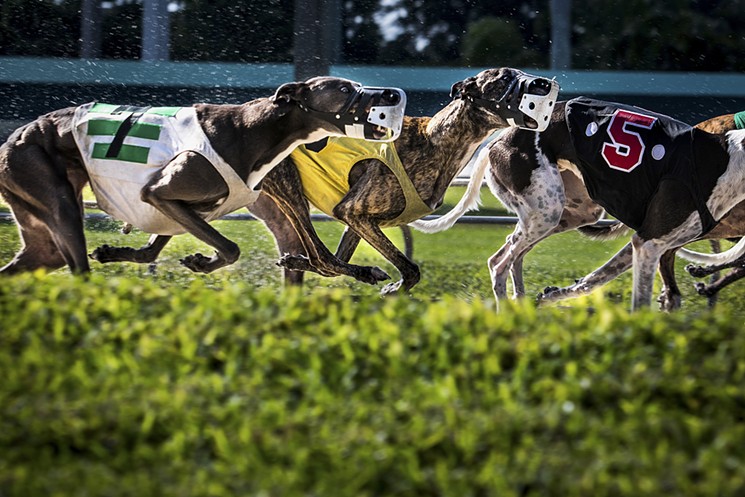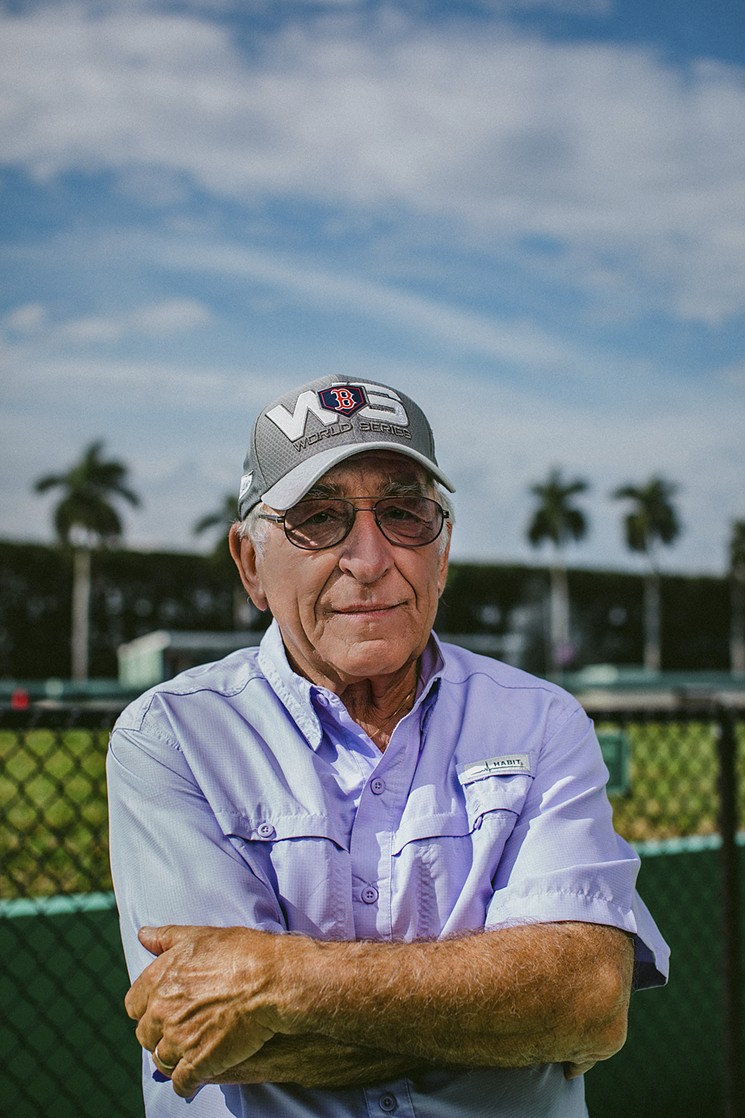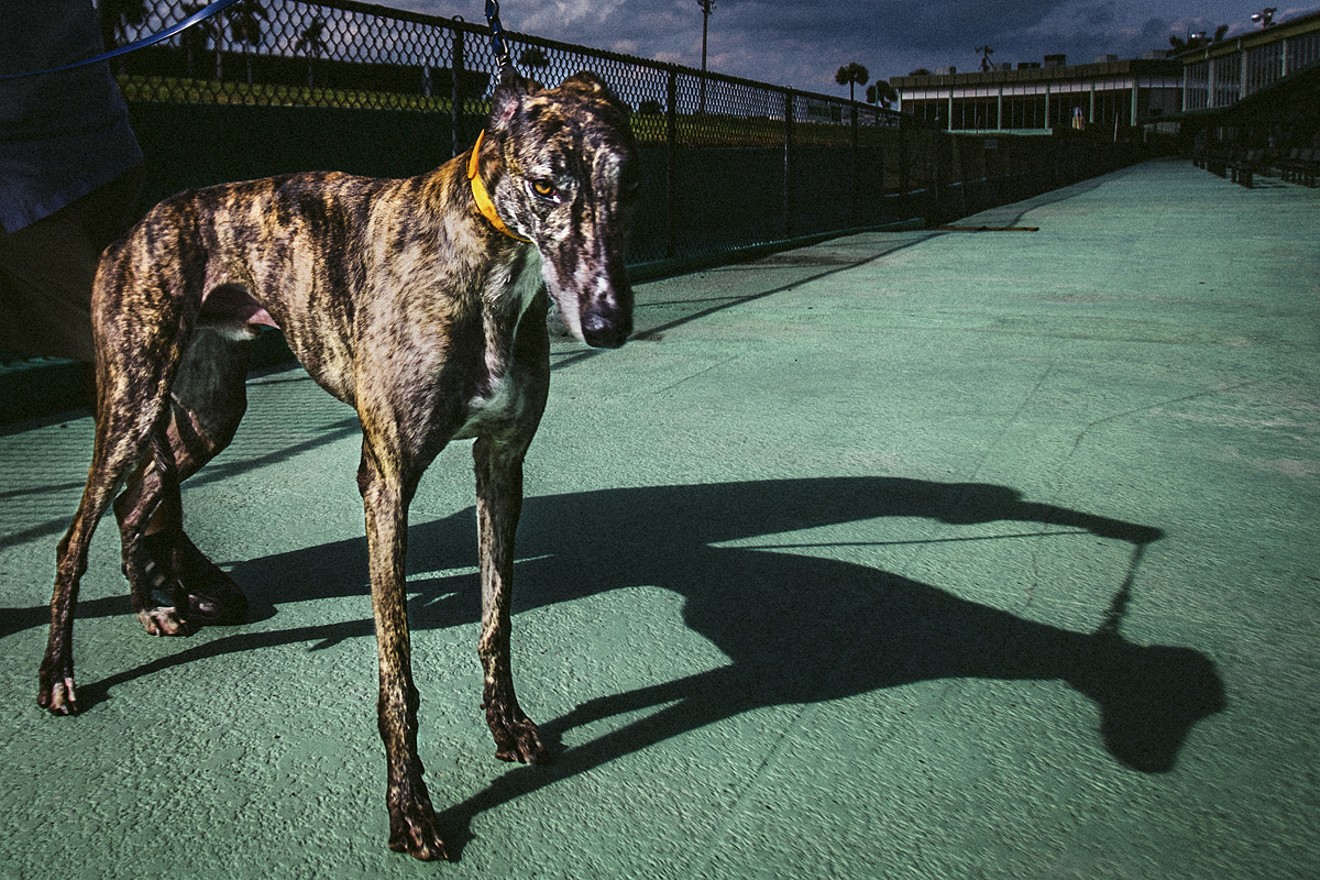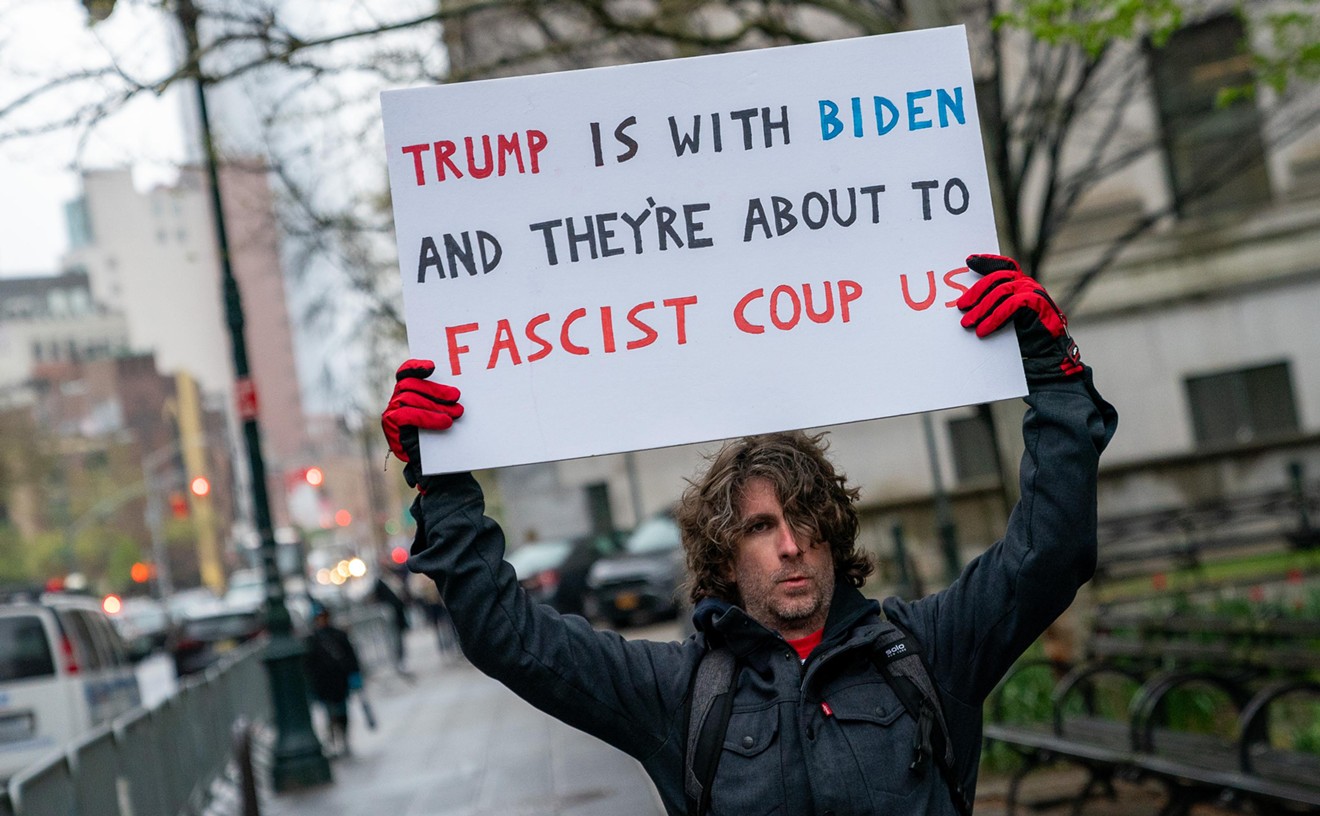Except for a scattering of white-haired regulars, the grandstand overlooking the old dog track at the Palm Beach Kennel Club is almost empty on a cold-for-Florida December day. Wearing hearing aids and World War II veterans' hats, a group of four long-timers holds court near the top of the stands. The youngest among them is approaching 80; the oldest is 92.
"Norman! Norm!" one of the men, a bespectacled, long-ago teacher named J.R., hollers at another. He waves a race program. "Did you look at Number Eight? In Race 12?"
"Race what?" the 90-something Norm asks, wheeling around and cupping his hand to his ear.
"Race 12. Look at the name: Reds Gaga," J.R. says. Turning to an observer, he explains, "That's his best friend. They were in kindergarten together. He just moved to assisted living."
"My friend Red," Norm says, a smile cracking beneath his mustache.
"Or is it your friend Gaga?" jokes Frank, another one of the men, and the foursome decides to bet on the 3-year-old dog with a tiger-striped coat. Frank, carrying the $55 they have left, walks over to the teller. As always, they began the day by pooling $200, piling into a car, and paying $5 for valet parking.
By the time the eight greyhounds spring from the gate and storm around the oval in a flash of fur and numbered jerseys, the four old friends are already gone, headed back down Interstate 95 to their Delray Beach neighborhood for a bridge game. When the announcer calls out the results of Race 12 — Reds Gaga came in eighth — the stands are even lonelier than before.
There was a time when the grandstand brimmed with enthusiastic
Now, almost a hundred years after the Palm Beach Kennel Club opened, the only dog track still operating in the onetime racing hub of South Florida is in its final days of running dogs. This past November, Floridians decisively voted to phase out the controversial practice by the end of 2020.
The Sunshine State has long been the heart of the so-called sport of queens, even after decades of dwindling popularity and profits. The first state to legalize dog racing, Florida is today home to 11 of the nation's 17 remaining tracks.
So the Election Day decision is a big deal, both to the racing fans, trainers, and tracks that keep dogs running ovals and to the animal activists, rescue groups, and politicians who fought to make them stop.
Supporters of the ban say it will free thousands of greyhounds that are regularly put at risk of injury or death, all for an archaic sport with a long record of cruelty to the oldest known breed of dog. But opponents argue that allegations of mistreatment are outdated and overblown and that the abrupt end of the racing industry, not the industry itself, is what put greyhounds in harm's way.
Soon an estimated 3,000 people will find themselves out of work, some whose families have been in racing for generations. Eight thousand greyhounds will need homes. An American pastime that dates back a century will enter what many predict to be its last stretch.
That greyhound racing is a dying industry has been widely known for years. Between 1991 and 2014, the total amount of money gambled on races across the nation fell from $3.5 billion to $500 million, according to a report by the Association of Racing Commissioners International. In that time frame, at least 40 tracks either closed or ended racing, including one in Key West and another in Miami. Seven states repealed laws allowing betting on live dog races.
In Florida, racing stubbornly persisted because of a quirk in state law that required tracks to host live racing to operate their more popular — and more profitable — card rooms. Looking to limit the number of gambling facilities, the state Legislature in 1997 passed a law restricting card-room licenses to existing "parimutuel" betting facilities: jai alai courts, horse tracks, and dog tracks. So the dogs had to run to keep the poker room open.
Because of that strange commingling of interests, efforts to end greyhound racing in Florida had simply sputtered and failed. Even efforts to stiffen regulation of the industry struggled to find traction. Finally, in 2017, Tom Lee, a Republican state senator from Tampa, proposed amending the state constitution to get it done.
"Trying to pass a
A member of the Florida Constitutional Revision Commission, which convenes every 20 years to propose changes for voters to consider, Lee found support for his measure, and it became one of 12 amendments that would go to voters in November. Amendment 13, as it would appear on the ballot, quickly drew an impassioned response.
On one side: Grey2K, a Massachusetts-based antiracing organization that lobbied to get the ban to voters, the Doris Day Foundation, and the Humane Society of the United States. On the other: the National Greyhound Association, which oversees racing; a coalition of greyhound adoption groups; and the thousands of people who work in the industry.
With $3 million to spend, the antiracing Committee to Protect Dogs — Yes on 13 flooded voters with commercials showing footage of track injuries and deaths. Two pro-racing PACs, Committee to Support Greyhounds and Say No to 13 had a measly $560,000.
In the end, the animal activists won, and by a wide margin: 69 percent voted to get rid of racing; 31 percent cast ballots to keep it. The racing industry claimed the measure had needlessly cost the jobs of Floridians and endangered the greyhounds on Florida tracks. The animal activists, meanwhile, cheered it as a clear sign that the end of racing, at long last, is within reach.

The night of the Palm Beach Kennel Club's first race, some 4,000 spectators filled the bleachers. The odds were calculated by hand, and the numbers were displayed on wooden placards. To figure out which dog won, three
The year was 1932 — 44 years before Florida would get its first professional sports team (the Miami Dolphins), 47 years before its first Seminole gambling operation (the Hollywood Bingo Hall), and 56 years before its first lottery game (Millionaire). Dog racing was big business, and the Palm Beach Kennel Club, which hosted races seasonally, was the place to see and be seen in the county of about 52,000. Stars such as John Wayne and Ed Sullivan were said to have passed through.
Florida's first dog track opened in Hialeah in 1922, nine years before betting on dogs was even legal. Some tracks skirted that restriction by offering the purchase of "options" of winning dogs. But in 1931, hoping to add money to the state's coffers during the Great Depression, legislators overrode a governor's veto to approve gambling on races. By 1935, the Sunshine State had ten greyhound tracks — several of them in South Florida — and they'd become a top tourist destination. Dog racing was as synonymous with trips to Florida as theme parks are today.
"Greyhound racing was a major sport," Miami historian Paul George says. "These were huge venues, and people went night after night."
Celebrities such as Joe DiMaggio, Babe Ruth, and Burt Reynolds could be spotted at Florida racing venues. Frank Sinatra shot a movie about a gambler at Miami's Flagler Dog Track. Al Capone supposedly had interests in the Miami Beach and Hollywood Kennel Clubs. And the opening sequence of Miami Vice featured a greyhound bursting from the box at the Biscayne track.
At the Palm Beach Kennel Club, a 4,000-seat grandstand was built in 1962 and the Paddock Room, a private club overlooking the track's first turn, opened in 1969. Art Rooney Sr., who'd founded the Pittsburgh Steelers with money he reportedly made betting horses, bought the place in 1970. He and his five sons paid about $7 million for the kennel club, which he had frequented during trips between Pittsburgh and Miami to bet on horses at Hialeah Park. (The family still runs the club today — Art's son Patrick Rooney Sr. is CEO of the club. Patrick's son Patrick Rooney Jr., a state representative from 2010 to 2016, serves as president.)
Dog racing's peak was in the '70s and
Nicknamed Rhonda, the dog came to prominence in late December 1993, when she began a winning streak. As she continued finishing first, fans showed up at the kennel club with "Pat C for President" banners. The star racer was fed filet mignon and ferried around in a white stretch limousine, and the lead-outs wore tuxedos. After breaking a world record in June 1994 with 33 consecutive wins, she made the New York Times, the Washington Post, and Sports Illustrated.
"Even when she slobbers, Pat C Rendezvous has a certain patrician air about her, a look of world-weary resignation one associates with good breeding and the foibles of lower orders," the Sports Illustrated story began. "And lately the performance of this 2-year-old brindle greyhound — a SportsDog if you will — has been as impeccable as her bloodlines."
Florida's first dog track opened in Hialeah in 1922, nine years before betting on dogs was even legal.
tweet this
Pat C Rendezvous' streak ended later
But even in those heady days, the racing industry was beginning to face a backlash over the fate of the thousands of dogs that didn't become champions.
At Sonia Stratemann's five-acre property off a dirt road in Loxahatchee Groves, a stampede of greyhounds gallops across the yard and stops, tails wagging and tongues lolling, to greet visitors. They're sleek and quick, and
All have blue-green tattoos inside their ears. A few have bald spots on their hind legs, a condition called "kennel butt" that comes from years of confinement in carpeted kennels. One, a friendly fawn hound named Josephine, keeps her right leg suspended while she runs the yard. "Broken leg," Stratemann explains with a sigh.
For years, the 46-year-old homeschooling mother kept quiet about the things she saw as she took in 2,300 dogs at the end of their racing careers. She didn't talk about the hundreds of broken bones or the otherwise healthy dogs dropped off at veterinary offices to be euthanized because of those fractures.
She said nothing as she paid for their surgeries and cared for as many as 20 at a time until she could find people willing to adopt them.
But she decided to end the uneasy truce about a year ago. She'd had three racing dogs with broken legs come in within ten days and had taken home another dog slated to be put down. Plus, the state's Constitutional Revision Commission was considering placing a question about greyhound racing on the ballot. For the first time, Stratemann thought the sport might be on its way out. She became a leading advocate for the ban.
"We had to hide everything for years in order to get the dogs in," she says. "I knew as soon as I started speaking out, I'd be cut off."
Sure enough, soon after Stratemann went public in a WPBF-TV report, the National Greyhound Association pledged to stop sending her dogs. She says she has lost friendships with industry folks and received screaming phone calls. In one particularly nasty line of attack, racing supporters have tried to discredit her by bringing up her teenage son's 2016 death in a polo accident.
Over the decades, stories had trickled out about the fate of the tens of thousands of dogs bred for the sport. As far back as the '50s, people in the industry were estimating that only around 30 percent of greyhounds born at breeding farms were suitable for racing. What happened to the rest was for the most part unknown.
At tracks across the nation, there were occasionally horrific, headline-grabbing accidents — dogs electrocuted, trampled, or euthanized on the track after suffering severe breaks. The majority, however, retired quietly after just a few years of racing. From there, it was often difficult to trace their paths.
But news stories told of former racers sold for experimentation or dissection, used in labs researching things including brain tumor treatment, hip replacement, and bone breakage. Others were killed by the dozens, dropped at veterinary clinics to be euthanized, or simply shot and dumped in empty fields.
The head of the National Greyhound Association, Guy Guccione, admitted in a 1993 Associated Press article that the industry had an annual death toll of 23,000 dogs. That number was significantly lower than the estimate from animal-rights activists, who put it around 50,000 at that time.
One of the most disturbing glimpses at the industry's dark underbelly came in
"These dogs were not unhealthy," the prosecutor, a onetime racing enthusiast, said. "They were just slow."

Arthur Agganis is up with his dogs before dawn every day. In one of 24 low-slung, air-conditioned buildings at a guarded compound not far from Sonia Stratemann's home, he spends his mornings tending to 120 greyhounds that run the Palm Beach track. He and his five employees wash the carpeting in their kennels, let the dogs out in small but clean turnout areas, and pass out bones to keep them occupied. After race days, he says, the sleek, muscular animals get whirlpool baths and massages.
At the kennel, Agganis and the others affectionately call the dogs by pet names instead of their more formal racing monikers. Some of Agganis' employees insist on visiting the brood Christmas morning even though they have the day off. When Hurricane Irma blew through in 2017, a couple of the workers camped out on the floor beside the dogs' crates. Agganis doesn't deny the problems of the past. But he insists his racing dogs are treated better than most household pets.
"Listen, it's all over now," he says. "I have no reason to lie to you. All I can tell you is those greyhounds live a great life. And if we ever get reincarnated as something else, I want to come back
The straight-talking Boston native owned a couple of gas stations in 1975 when a customer told him he should invest in greyhounds. "I thought he was talking about buses," Agganis says, chuckling. After buying a couple of dogs, he got hooked and became a full-time trainer. He moved his kennel from the Wonderland track to the Palm Beach Kennel Club in 1990 after his son earned a baseball scholarship to Florida Atlantic University.
Greyhound racing has been Agganis' livelihood for the majority of his life, and he calls November's vote a "travesty." Like many trainers, he feels betrayed by politicians who ignored repeated invitations to visit his kennel and by state officials who in September announced a rule barring nonemployees from going behind the scenes at tracks. The rule change came just days after the National Greyhound Association revealed plans to offer tours at the Palm Beach Kennel Club and two other facilities.
Those who work in the industry or support it harbor plenty of anger. They blast the antiracing groups that backed the amendment as out-of-state extremists who spent
"When you spend $3 million lying," industry lobbyist Jack Cory says, "sometimes you can sell ice cubes to Eskimos, I guess."
Trainers say claims of mistreatment are flat wrong and, as proof, point to the fact that retired racers easily find homes. They argue that if the
"Greyhound racing was a dying sport, and we were hoping that it would die out on its own and not be forced out," says Mary Ann Grzybowski, president of the pro-racing Greyhound Pet Adoption Florida — Southeast. She calls the sport "poetry in motion."
As for the broken legs, Agganis argues they're no different from injuries that occur in any other sport. "You know what? My grandchildren get hurt playing little league; then they get better and play again. Are you kidding me? Are we all supposed to live in a bubble?"
The industry has long resisted efforts to mandate the reporting of on-track injuries. But one fact proved difficult to overcome: Beginning in 2013, a new law required the disclosure of all deaths at racing facilities. In the past five years, state records show, nearly 500 greyhounds died.
Racing supporters point out the number is a tiny fraction of the tens of thousands of dogs that ran Florida tracks in that time frame and includes those that die of natural causes. Jennifer Newcome, a second-generation trainer who led the pro-racing Committee to Support Greyhounds, tells the story of a black dog named Hallo Gulch. She says she took him to the vet after he began acting strangely. That's when she learned he had incurable cancer.
"We made the decision to have the dog euthanized," she says. "I sat with the dog while it was going on. I was a mess. I couldn't even drive. I left crying, hysterical. I have his ashes, I have his collar, I have his kennel muzzle. Five years later, I still have it with me. I still think of him and I still miss him. He's on that list."
She and others in the industry feel bruised by months of being portrayed as animal abusers. They say the vast majority of dogs finish racing and go on to live happy second lives as family pets. Now, Cory says, his organization is gearing up to ask the Legislature for $500 million to compensate the thousands of people who will soon lose their racing-industry jobs. If his plea doesn't work, he's already hinted at filing a lawsuit.
Many racing proponents say they were shocked by November's results — none more than Agganis, who found out he had cancer the same week.
"I've been in the business 43 years, and in a year and a half, I'm out of a business and out of a job," he says. "And it's all I've done all my life."
Not knowing what to expect after their parents pulled them out of school early for a surprise, five kids slip hesitantly into the kennel in Sonia Stratemann's backyard. The barking starts right away. Seven dogs, eager to meet their visitors, peer out from their crates. "What! You're kidding, Dad!" 10-year-old Judah yells. "This one, this one, this one!" his sister says, jumping up and down and pointing at a cage.
Before long, Anna and Ben Thomas and their children have decided to adopt not just one greyhound, but two. "Merry Christmas!" says a beaming Ben, a reverend at a Boca Raton church. Tears stream when the kids realize they have to wait a few weeks before taking their new pets home.
Perhaps the biggest change in the two months following the vote to end dog racing in Florida is the sudden influx of people wanting to adopt greyhounds. Adoption groups say they've been overwhelmed by
"Since the amendment passed, my phone does not stop ringing," says Mary Ann Grzybowski of Greyhound Pet Adoption Florida — Southeast. "My husband has threatened to throw it in the pool."
Most of Stratemann's greyhounds are coming from a shuttered racetrack in China that has been called the worst in the world. But the two dogs the Thomases are adopting were bred for racing in Florida.
Cory, the racing-industry lobbyist, says the National Greyhound Association will work with 102 adoption groups across the nation to place the dogs once they finish racing. Organizations that supported the ban will not be allowed to participate. Racing-industry leaders say breeding has already slowed at farms, and the greyhound association has been preparing for the shuttering of Florida's tracks.
Back at the Palm Beach Kennel Club, officials did not respond to interview requests. Joe Rooney, another grandson of Art Sr., told ESPN in October that the racetrack would sell most of its 19 acres and cut its staff from 600 to 100. Despite the emptiness of the grandstand, he said greyhound racing brings in money from those watching and betting online. Now, with racing on the way out, the track will concentrate on its card room and simulcasts of races happening elsewhere.
There's an air of resignation among even longtime fans who visit multiple times a week to bet on the dogs, among even the enthusiasts who pay for the tip sheets, sit in the same seat every day, and know all the track regulars.
"Racing was
For now, though, the












